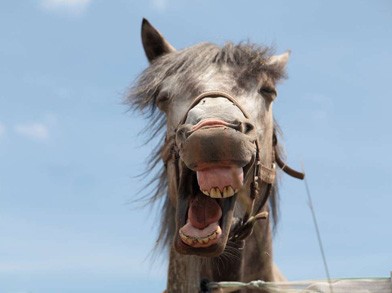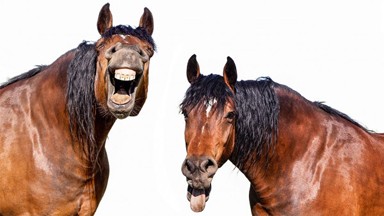Horse Facial Expressions Mirror Humans

By Julianne Glaser
Body language and facial expression in particular are a nonverbal language that’s universally understood. Around the globe, a smile conveys unequivocal happiness while a scowl shows contempt. Humans, in fact, can convey more than 27 emotions through facial expressions alone. Interestingly, new research has revealed that humans are not the only species to utilize facial movements to display emotion.
Studying Equine Expression
Psychologists at the University of Sussex in the U.K. recently reported in PLOS One that horses also use the muscles underlying their facial features, particularly the eyes, nostrils and lips, to reveal their emotions to other horses in a variety of social situations. In this extensive study, researchers analyzed videos of natural horse behavior and expressions to identify specific facial movements and the corresponding musculature. To capture this data, researchers created a coding system called EquiFACS (Equine Facial Action Coding System), which they used to describe and classify each individual facial expression.

Using EquiFACS, Jennifer Wathan, a researcher at the University of Sussex and one of the study’s authors, and her colleagues discovered that horses can create 17 recognizable facial movements, such as “ears forward,” “upper lip raiser” and “nostril lift.” Comparatively, cats make 21 movements, dogs make 16 and chimpanzees make 13. This research demonstrates that horse expressions are far more complex than previously presumed and surprisingly similar to those of humans, despite anatomical differences in facial structure.
“Horses are undoubtedly emotional animals,” according to Wathan, “but what they feel and how that is expressed is a question that we have yet to pin down.” Results from this study have supplanted the previous theory that species distantly related to humans have far more simplistic facial expressions. For example, horses tend to raise their inner brow in negative emotional situations to express sadness or fear, in a manner very similar to humans and dogs. Wathan believes this research could have positive implications in veterinary settings and in horse training programs and plans additional studies to identify the specific socio-emotional information horses communicate through their complex facial expressions.
Extension Questions
- What additional implications does this research have for how we understand and relate to horses and other species?
- What other animals use complex facial expressions and body language? Are there similarities in their nonverbal communication?